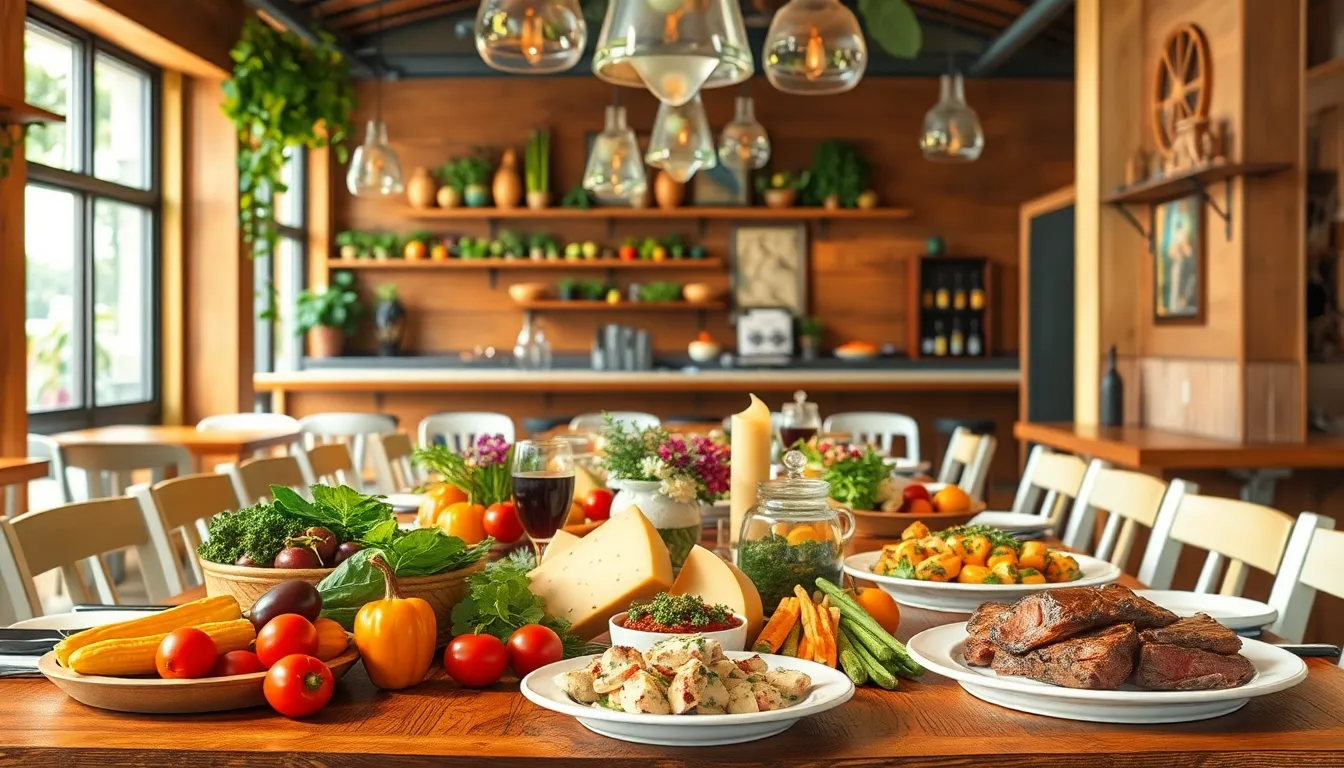In a city known for its theme parks and sunshine, Orlando’s culinary scene is taking a delicious turn with the rise of farm-to-table restaurants. Imagine biting into a juicy burger made from grass-fed beef, paired with crispy veggies that were still waving at the sun just hours before. It’s the kind of dining experience that makes you feel good about what’s on your plate—and the planet too!
Farm To Table Restaurants Orlando
Farm-to-table restaurants in Orlando focus on serving dishes made with fresh, locally-sourced ingredients. These eateries create menus that change seasonally, highlighting the best available produce from nearby farms. Grass-fed beef, free-range chicken, and organic vegetables frequently grace the menus. Chefs in these establishments emphasize quality, ensuring that every plate reflects the flavors of the region.
Sustainability plays a significant role in the farm-to-table movement. Many restaurants partner with local farms, reducing carbon footprints and supporting the community. This commitment to local sourcing not only enhances the freshness of the food but also bolsters the local economy. Diners can enjoy meals with the peace of mind that comes from knowing their food is supporting local agricultural practices.
In addition to freshness and sustainability, these restaurants often foster a sense of connection between the diners and the food’s origins. By highlighting the specific farms and producers, they create a narrative around each ingredient. This storytelling aspect invites guests to appreciate the culinary journey from the farm to their table.
Customers in Orlando increasingly seek out farm-to-table options, reflecting a broader trend toward health-conscious dining. These restaurants accommodate various dietary preferences, offering vegan, vegetarian, and gluten-free options crafted from the same high-quality, local ingredients.
Overall, farm-to-table restaurants provide a unique dining experience that prioritizes freshness, sustainability, and community engagement. This movement not only transforms menus but also cultivates a deeper appreciation for the culinary arts and local agriculture.
Benefits of Farm to Table Dining

Farm-to-table dining offers numerous advantages that enhance both the culinary experience and community well-being. Enjoying meals prepared with local, seasonal ingredients not only ensures top quality but also fosters a unique connection to the food source.
Freshness and Quality of Ingredients
Fresh ingredients shine in farm-to-table restaurants. They use produce picked at peak ripeness, bringing out vibrant flavors in every dish. Seasonal menus highlight the best local offerings, allowing chefs to create innovative recipes. Grass-fed beef, organic vegetables, and artisan cheeses are commonplace in these establishments. Each bite reflects the dedication to sourcing high-quality items, enhancing nutritional value. Dishes taste better when made with ingredients that traveled short distances to the kitchen. Sourcing directly from local farms maintains optimal freshness, providing diners with an exceptional experience.
Supporting Local Farmers
Supporting local farmers strengthens the regional economy. Farm-to-table restaurants partner with nearby agricultural producers, ensuring that monetary resources circulate within the community. Many eateries prioritize forming relationships with small-scale farms, which fosters a sense of trust and accountability in sourcing practices. This approach helps preserve local agriculture and promotes sustainable farming methods. Consumers may find a greater variety of fruits and vegetables as restaurants adapt their menus to highlight seasonal abundance. Rather than relying on large distributors, restaurants champion the hard work of local farmers, ultimately benefiting everyone involved.
Popular Farm to Table Restaurants in Orlando
Orlando’s farm-to-table scene features a variety of innovative restaurants, each showcasing the region’s agricultural bounty. Diners appreciate the fresh flavors that define these unique establishments.
Unique Menus and Concepts
Menus at farm-to-table restaurants evolve with the seasons. Chefs craft dishes that reflect the freshest local produce available. For example, seasonal ingredients, such as heirloom tomatoes and organic greens, star in vibrant salads and hearty entrees. Special concepts, like farm-themed dinners and chef collaborations, enhance the dining experience. Each restaurant embraces creativity, offering patrons an opportunity to explore diverse culinary combinations. Diners enjoy not only distinctive flavors but also the stories behind each dish and its ingredients.
Ambiance and Dining Experience
Ambiance in farm-to-table restaurants emphasizes warmth and connection. Rustic decor often features reclaimed wood and local artwork, creating an inviting atmosphere. Many establishments include open kitchens, allowing guests to witness culinary artistry firsthand. Friendly staff enhances the experience with knowledgeable recommendations about the menu and sources of ingredients. Outdoor dining options often showcase lush gardens or farm views, further connecting diners to the origins of their meals. Overall, these restaurants captivate visitors with a memorable experience that transcends food, fostering community and appreciation for local agriculture.
How to Choose the Right Farm to Table Restaurant
Selecting a farm-to-table restaurant requires attention to several key factors. Look for restaurants that emphasize local sourcing, ensuring ingredients come from nearby farms. Menus should vary seasonally, reflecting the freshest produce available.
Consider the dining experience as well. An inviting atmosphere, often with rustic decor and open kitchens, enhances the connection to the food. Friendly staff who understand the menu and ingredient origins add value to the visit.
Investigate the restaurant’s partnerships with local farmers. Notable establishments often highlight their sources, fostering trust and transparency in their food supply. Checking reviews or testimonials can provide insight into the quality of dishes and overall customer satisfaction.
Evaluate dietary options available. Many farm-to-table restaurants cater to various dietary preferences, including vegan, vegetarian, and gluten-free dishes, underscoring their commitment to health-conscious dining.
Analyze the overall approach to sustainability as well. Restaurants should demonstrate practices that reduce their carbon footprint, like minimizing food waste or composting. These elements enhance not only the dining experience but also the restaurant’s contribution to community well-being and environmental responsibility.
Incorporating these factors ensures a rewarding dining choice. Prioritize venues that align with personal values regarding freshness, sustainability, and community support. Each visit to a carefully chosen farm-to-table restaurant deepens appreciation for local agriculture and culinary artistry.
Conclusion
Farm-to-table restaurants in Orlando offer a unique culinary experience that goes beyond just food. They connect diners with the local community and the origins of their meals while promoting sustainability and health-conscious dining. By choosing these establishments, patrons not only enjoy vibrant flavors but also support local farmers and the regional economy.
As the trend continues to grow, Orlando’s farm-to-table scene is set to flourish, inviting food lovers to explore innovative menus that change with the seasons. The emphasis on fresh ingredients and sustainable practices enriches the dining landscape, making each meal a celebration of local agriculture and culinary creativity. Embracing this movement allows diners to savor the best of what Orlando has to offer while contributing to a more sustainable future.

